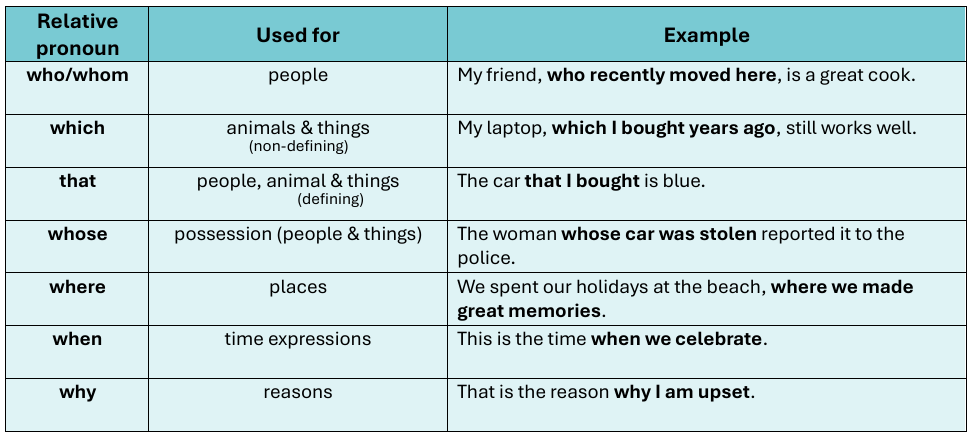Relative Clauses
In English there are a variety of ways to add detail and depth to our sentences. Relative clauses are a powerful tool to do just that. Whether describing a person, an object, a place or a time, relative clauses help you paint a clearer picture for your reader or listener. Read on to learn more and work through relative clause activities.
What Are Relative Clauses?
Relative clauses are a type of dependent clause that provide more information about a noun. They begin with relative pronouns such as who, which, that, whose, where, or when.
Relative clauses are useful to avoid repeating information. Take this example:
The book is fascinating. I borrowed it from the library.
By using a relative clause, we can combine these clauses and avoid repeating ourselves.
The book that I borrowed from the library is fascinating.
Here is another example:
She is the teacher. She helped me with my homework.
She is the teacher who helped me with my homework.
In these examples, the relative clauses add details about the noun and helps to avoid repetition.
Types of Relative Clauses
There are two kinds of relative clauses: defining and non-defining.

Defining Relative Clauses
These clauses give essential information about the noun they modify. Without them, the sentence wouldn’t be complete or clear. For example,
The man who fixed my car did an excellent job.
Let’s image this sentence without the relative clause:
The man did an excellent job.
The sentence is confusing without the relative clause ‘who fixed my car’; we don’t know which man did an excellent job. The defining relative clause is necessary for identifying the subject of the sentence.
Non-Defining Relative Clauses
Non-defining clauses provide extra information that can be left out without making the sentence unclear. The clauses are always separated by commas. For example,
My brother, who lives in Sydney, is coming to visit.
Let’s imagine this sentence without the relative clause:
My brother is coming to visit.
Without the relative clause ‘who lives in Sydney’, the sentence is still clear and complete. The non-defining relative clause adds additional, non-essential information.
Relative Pronouns
Relative clauses begin with a relative pronoun. It’s important that we choose the correct pronoun or adverb to use. ‘Who’ is used to refer to people. ‘Which’ is used for animals and things. ‘That’ can be used for people, animals and things. That’ and ‘which’ can both be used to refer to animals and things, and so they are often confused. Generally speaking, ‘which’ is used for non-defining relative clauses, and ‘that’ is used for defining relative clauses. ‘Whose’ shows possession and is used for people or things. ‘Where’ is used to refer to places. ‘When’ is used for time expressions. ‘Why’ is used to refer to a reason.

Video: Understanding Relative Clauses
More Relative Clauses Practice
Relative Clause Quiz
Ready to put what you’ve learned about relative clauses into practice? Take the quiz!
Try and listen out for relative clauses people use in everyday conversation. They’re used more frequently than you might think! This is a tricky topic, so be sure to keep practising the relative clause activities—step by step—you’ve got this!

Leave a Reply